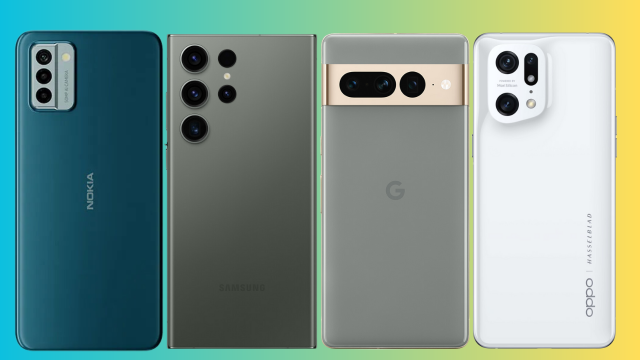Samsung, Google, Oppo, Motorola, Nokia, TCL, Vivo, ASUS, Xiaomi, Realme. There are so many Android phone brands out there that it can often be quite difficult to tell the difference between them.
That being said, we reckon there are a few definitive features and aspects between these brands that make them unique.
Let’s go through some of these Android phone brands and talk about what makes them special.
Samsung’s Android phones
Samsung is the most popular Android phone maker, and the most popular phone maker globally. For many people, Samsung is the go-to Android phone brand, with its proprietary OneUI operating system, a layer that exists ontop of the Android operating system, and its reliable camera tech (though that has come under scrutiny recently).
Samsung’s product range is consistent, with premium-level phones available with the ‘Galaxy S’ prefix, experimental foldable phones with the ‘Galaxy Z’ prefix and budget-range phones with the ‘Galaxy A’ prefix (and within these divisions, phones are available across wide price points). Across these divisions, Samsung has many more phone models available at any given time than pretty much any other Android phone maker. Android users often gravitate towards Samsung as a trusted brand, and one that offers great camera and software performance.
Google’s Android phones
Google’s Android phone range is limited, but that’s kind of what makes it special. Unlike Samsung, which has three different product ranges, Google only has one – the Pixel series. Within the series, there’s the standard ‘Pixel’ phone (which is currently the Google Pixel 7), the ‘Pixel Pro’ and the ‘Pixel A’, a budget variant of the standard Pixel phone (currently the Google Pixel 6a, though likely to be the 7a next). It’s rumoured that a foldable will also join the range sometime soon.
With such a limited product range, it’s easy to tell which phone is which. Google is widely recognised for its camera performance (which Gizmodo Australia loves), for its groundbreaking budget phone and for its unique camera bar. Additionally, Pixel phones don’t come with much bloatware, if any, as Google owns the Android operating system. It’s remarkably polished without many unnecessary extra bits.
Oppo’s Android phones
Moving on to Oppo, an Android phone brand that offers devices similarly to Samsung, Oppo’s bread and butter is offering a highly customisable operating system. Just like Samsung, Oppo offers a budget range of smartphones with an ‘A’ prefix, however, Oppo’s premium range is divided between the ‘Reno’ series (which are sold between $600 and $1,100) and the ‘Find X’ series (which retail between $1,200 and $1,800). There’s also a foldable range: ‘Find N’.
Cameras are a great focus for the company, but ColorOS and its ease of use is the highlight of any Oppo device. Oppo devices also tend to have quite a premium feel to them across all price ranges.
Nokia’s Android phones
Next up we have Nokia, one of the phone giants from before the world of smartphones. These days, Nokia makes budget-oriented devices, the most expensive of which retail for $899 and the cheapest for $159. Despite its focus on affordability, Nokia does make a unique device from time to time, such as the Nokia G22, a smartphone built around being easily repairable. Nokia’s sub-$250 devices are characterised by a ‘C’ prefix, its sub-$550 devices by a ‘G’ and its sub-$899 devices by an ‘X’.
Affordability is the north star of these products, though their chassis can feel quite tacky.
Motorola’s Android phones
Lastly, we have Motorola, best known for its ‘Razr’ flip phone during the 2000s and now mostly a budget phone manufacturer. Motorola’s most well-known phone today is, of course, a call-back to the Razr phone, taking the form of a folding-screen smartphone called, you guessed it, the Motorola Razr (the only phone in the ‘Razr’ category, starting at $1,400).
Within the Motorola range, it’s difficult to tell which phones are which, as phone prefixes are not uniformly in line with price. Both the ‘E’ and ‘G’ prefixed phones target budget-minded customers, while the ‘Edge’ range is Motorola’s premium device category, with devices priced between $449 and up to $1,400. The flagship device of the Motorola range is the Motorola Edge 30 Ultra 5G, however, the company recently released the Motorola Thinkphone, a $999 device that attempts to be a jack-of-all-trades.
Happy Android shopping
The above are some of the more well-known Android phone brands in Australia, ones we tend to vouch for most. They’re all quite similar but differ in their own, unique way. Click through to some of the links above to get a more focused understanding of each brand and its specific devices. Happy Android phone shopping, folks.
